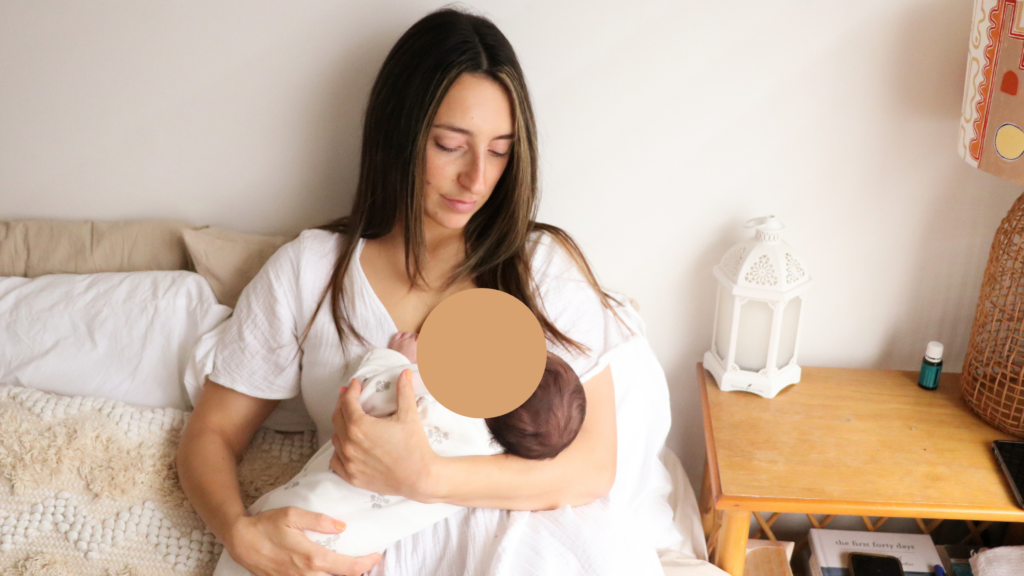As a Postpartum Holistic Nutrition Consultant and Mama who has experienced mastitis twice before, I want to share some ways to treat mastitis before using antibiotics. I hope this post gives you practical solutions to implement before resorting to antibiotic treatment.

Before we get to the nitty-gritty details of of how to treat mastitis naturally, here is my mastitis story.
I have had mastitis with my first born and third born. With my first born, I was able to tackle it before it got out of control. I used a range of natural remedies and stayed on top of it until it passed.
When I had my third baby, I missed the window of treating it naturally and it got out of control to the point where I needed antibiotics. Otherwise I would have ended up in hospital.
Mastitis is an excruciating experience that many women endure through without realising how they can treat it before turning to medication.
I am in no way saying that I am against antibiotics. It saved me when I had mastitis with my son. However, antibiotics disrupts your gut microbiome and so if you can avoid it, then do all you can to.
What I will be covering in this post
- What is mastitis?
- What are the symptoms?
- Natural remedies to treat it
- When to use antibiotics and when to use probiotics
- Conclusion

What is mastitis?
Mastitis is the swelling and inflammation of breast tissue, which can lead to infection if not treated properly. It often happens in one breast at a time, but can sometimes happen in both breasts simultaneously.
Research has concluded that mastitis can occur from a multiple of factors including, hyperlactation (oversupply), microbial factors, such as the diversity of the milk microbiome and the use of antibiotics (study).
What you may not know is that there are two types of mastitis: inflammatory mastitis and bacterial mastitis.
Inflammatory mastitis is when the ducts progressively narrow in. It presents as painful swelling and reddening of skin on the breast and you will likely experience a fever, chills and increased heart rate.
Bacterial mastitis is the progression of inflammatory mastitis that usually resolves itself with the use of antibiotics. It presents itself as cellulitis, with increasing redness and hardening of soft tissues in a specific region of the breast that usually spreads to different quadrants.
Bacterial mastitis is not the result of poor hygiene and not contagious, so you are able to keep feeding without sterilising pumps or anything of the sort.
What are the symptoms?
If you have mastitis, you will experience some of the following:
- breast tenderness
- breast swelling and redness
- thickening of breast tissue or a breast lump
- pain or burning sensation while breastfeeding
- feeling ill (like when you have the flu)
- feverish (source).
Natural ways to treat it
I am a firm believer that you should seek natural remedies to treat symptoms before resorting to medication, especially while breastfeeding.
In order to treat it naturally, you need to begin treatment at the onset of the mastitis symptoms, otherwise it will be too late.
Feed on demand: when a mastitis symptom begins to present itself, feeding on demand is important. It is crucial to note that emptying out the breast is not required, as this will only overstimulate the supply and worsen symptoms. Some women find that it helps to feed from the unaffected breast first and then the infected breast to avoid overstimulation.
Massaging: previous recommendations when massaging were to massage the infected area firmly, with sufficient pressure toward the nipple. However, current research shows that this type of massaging could lead to tissue trauma and should be avoided. Instead, it is better to perform a gentle, lymphatic drainage massage, which is a light sweeping of the skin rather than deep tissue massage. Sweeping up from the nipple toward the armpit is supposed to drain extra fluid and reduce inflammation.
Ice: It was once recommended that applying heat to the infected area helps reduce the swelling. However, current recommendations suggest that heat increases blood flow and may contribute to swelling. Applying ice packs or cold compresses are now recommended, as the cold helps to reduce blood flow to the area and reduce the swelling altogether.
Rest: it seems obvious, but rest is important when experiencing mastitis symptoms, so that you can focus on recovery and not over-extend yourself. Over-extending yourself may lead to missing the symptoms and the mastitis worsening.
Sunflower lecithin: it is suggested that 5-10g of sunflower lecithin divided in doses, reduces inflammation in the milk ducts and decreases the viscosity of breast milk flow (my recommended sunflower lecithin drops here).
Poke root tincture or phytolacca decandra homeopathic: traditionally used by midwives and is safe for breastfeeding with high rates of satisfaction (study). Find my recommended poke root tincture here.
Ensure that you are wearing a loose bra and top: tight clothing can reduce proper milk flow and contribute to inflammation.
Ensure that baby has a proper latch: consult with a lactation consultant if in doubt.
When to use antibiotics and when to use probiotics
While antibiotics should be reserved for bacterial mastitis, it is not recommended to be used for inflammatory mastitis. Some women will experience relief after antibiotics use when experiencing inflammatory mastitis. However, studies show that the use of antibiotics for the treatment of inflammatory mastitis disrupts the breast microbiome and increases the risk of bacterial mastitis (source).
Instead, a preventative approach would be to take a high quality probiotic. Specific strains have been shown to support their use with mastitis, like, ligilactobacillus salivarius or limosilactobacillus fermentum.
Conclusion
Aim to naturally treat the mastitis with the suggestions I have mentioned, with the use of a high quality probiotic. This will reduce the likelihood of developing bacterial mastitis and having to resort to antibiotics.
Please hear me out, that I am not against antibiotics. If it comes to having to turn to antibiotics, then please do so with caution.
If you do use antibiotics as a last resort, then I would suggest supplementing with a high quality probiotic to help restore your gut microbiome.
More on the blog
Gut-friendly unicorn yoghurt slices for kids
Leave a Reply